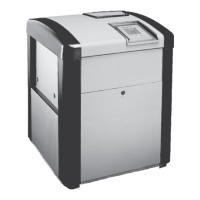Page 38
Before making a damper adjustment, run the
heater for ten or fifteen minutes to assure steady
operation and measure the flame signal. Adjust the
damper to provide a signal of five to seven µamps. A
higher signal indicates a "low" flame that produces
excessive NOx and may cause burner failure. A lower
signal indicates a less stable flame that may lift and go
out when the unit is cold.
10.4 Heater Components and Their
Operation
1. Gas Valve / Regulator - The gas valve controls
gas flow into the manifold. It provides flow only
when the temperature control requires heat and
only if all safety controls enable operation. It is
also a positive pressure regulator. It regulates the
gas pressure in the manifold to specifications
addressed earlier in this manual. This is neces-
sary for proper operation of the burner system.
2. Temperature Control - Both the LX and LT
Low NOx heater models are equipped with an
electronic control which senses water tempera-
ture by means of a thermistor and controls heater
operation to bring the water to the temperature
selected. It has an option for two separate
thermostat settings which are typically used to
set pool and spa temperatures.
3. Ignition Control - The ignition control provides
energy for ignition of the air/gas mixture, moni-
tors the flame and controls the gas valve. When
the temperature control requires heat, the ignition
control provides a pre-purge of the combustion
chamber. Once the pre-purge is complete the
ignition control lowers the blower speed and then
applies electrical power to a "hot surface" igniter.
When the igniter is hot enough, the ignition
control opens the gas valve. It has sophisticated
means to sense ignition and flame condition so
that unburned gas will not escape. Once the
ignition control has sensed flame, it de-energizes
the igniter and returns the blower to full speed.
After the burner is shut off, the ignition control
continues blower operation to provide a post-
purge period.
4. Igniter - The hot surface igniter is a crystalline
element which becomes very hot when electrical
power is applied to it. The hot surface igniter
directly ignites the air/gas mixture in the combus-
tion chamber.
5. Limit Switches - Two limit switches prevent
excessive water temperature - one within the
heat exchanger and one for water leaving the
heater. If either senses excessive temperature,
burner operation is interrupted.
6. Water Pressure Switch - This control senses
whether or not water is available to the heater by
measuring back pressure inside of the heat
exchanger. If the pool water pump fails or the
water filter is blocked, the pressure switch
prevents operation of the burner.
7. Fusible Link - This is a single-use switch which
detects abnormal temperature in the component
compartment of the heater. It is a fusible link
which is held to the combustion chamber just
above the burner tray by a sheet metal bracket.
Excessive temperature in the component com-
partment, possibly due to a burner flash-back will
cause the link to fail. This opens the safety
circuit which shuts off the gas valve and shuts
the heater down.
8. Air Pressure Switch - This switch verifies that
air is flowing through the combustion system by
sensing pressure. It shuts off the heater if air
flow is inadequate.
9. Flame Sensor - The flame sensor is the elec-
trode through which the ignition control detects
"rectification" of current passed through the
flame. Inadequate rectification indicates an
unsatisfactory flame condition. The rectification
signal can be measured by attaching the leads of
a DC ammeter to the two pins on the connector
of the ignition control labeled "FC". A wire
harness, available from Jandy, makes it easier to
attach the voltmeter leads. The flame current
should not be less than 1.5 micro-amps. If the
flame signal is less than 1.5 micro-amps, you can
adjust the throttle strip on the burner tray to allow
more air into the combustion chamber. This can
increase the flame signal.
10. Exhaust Temperature Limit Switch - A
manually resetable limit switch prevents exhaust
temperatures in excess of 240°F (116°C). If it
senses excessive temperature the switch opens
and burner operation is interrupted. Once the
cause of the excessive exhaust temperature has
been corrected, the switch may be reset and
used again.
10.5 Electrical Troubleshooting
This section describes procedures for checking
the electrical power and control components of the
heater one at a time and in the order they appear in the
control circuit. It is important to follow the sequence of
this trouble shooting guide because the safety circuit is
connected in series.

